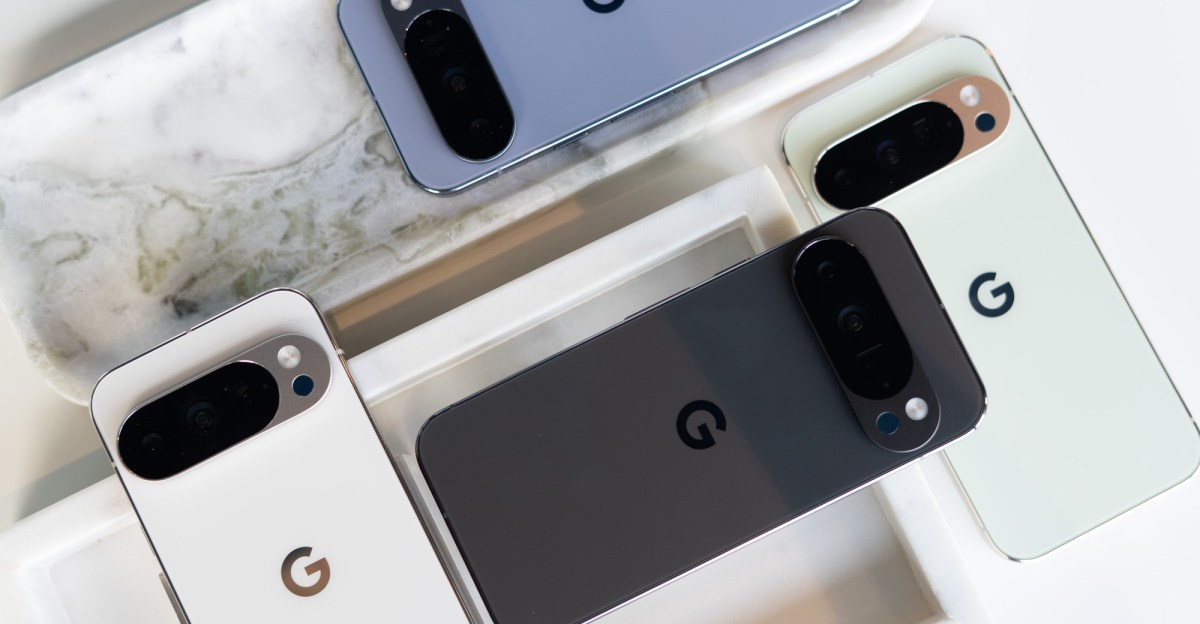
Google Pixel 10 and 10 Pro: G5 chip, Qi2 charging, and AI everywhere
Sources: https://www.theverge.com/hands-on/761055/google-pixel-10-pro-hands-on-camera-gemini, theverge.com
TL;DR
- Google announces the Pixel 10, Pixel 10 Pro, and Pixel 10 Pro XL with the Tensor G5 chip, Qi2 wireless charging, and a strong focus on on‑device AI capabilities.
- The phones introduce Pixelsnap magnets on the back for Qi2 charging, plus official accessories like a magnetic stand charger with a detachable puck and a ring-type grip that doubles as a stand.
- Availability and pricing remain close to last year: Pixel 10 starts at $799, Pixel 10 Pro at $999, and Pixel 10 Pro XL at $1,199 (256GB variant); the cheaper 128GB Pro XL is not offered.
- Camera and battery configurations vary by model: the regular Pixel 10 uses a 48MP main sensor with a 13MP ultrawide and adds a telephoto lens (5x); Pro models use a 50MP main sensor and a 48MP ultrawide; Pro/XL sizes and capabilities differ, with AI enhancements across the camera app.
- AI features are emphasized, with on‑device execution across apps and new tools like Magic Cue, AI-driven photo editing, and a translator that can mimic voices for translations. These devices are available for preorder now and will be on shelves August 28. Pixel 10 and 10 Pro prices align with last year; 10 Pro XL starts at $1,199. Source: The Verge’s hands-on coverage of the Pixel 10 series.
Context and background
Google has formally announced its Pixel 10 lineup, including the Pixel 10, Pixel 10 Pro, and Pixel 10 Pro XL. A central theme across the trio is the introduction of the Tensor G5 processor, which is notable as Google’s first Tensor chip manufactured by TSMC after four generations of Samsung-manufactured silicon. Google describes the CPU as, on average, 34 percent faster than the Tensor G4, with a claimed 60 percent uplift for on‑device AI tasks performed by the TPU. The emphasis on on‑device AI continues across the software features, including Magic Cue and a variety of AI-assisted camera and editing tools. In addition to processing upgrades, Google adopts the Qi2 wireless charging standard and introduces a magnets-based back called Pixelsnap. The back ring of magnets enables compatibility with Qi2 charging and opens up a growing ecosystem of MagSafe-style accessories. Google will ship a magnetic stand charger with a detachable wireless charging puck and a ring-type grip that can also function as a stand. The company notes compatibility with roughly nine million different MagSafe accessories, highlighting broad accessory support for the Pixel 10 family. On the software side, Google highlights a suite of on‑device AI features. Magic Cue is designed to proactively suggest text or data to paste into apps based on context. The feature works with first‑party apps like Messages, Calendar, Gmail, and the Phone app, and it is also embedded into Gboard for cross‑app suggestions. Google confirms the AI runs entirely on the device and is designed to be ephemeral, drawing on recent activity without storing content for long periods. Availability details indicate preorder today with a release to shelves on August 28. Pricing remains aligned with the prior generation for the standalone Pixel 10 and Pixel 10 Pro, while the Pixel 10 Pro XL starts at $1,199 and does not offer a $1,099 128GB version this time around.
What’s new
Hardware and performance
- Tensor G5 is introduced as Google’s new system-on-chip, built by TSMC after four generations of Samsung fabrication. The CPU performance is claimed to be roughly 34 percent faster than Tensor G4, with TPU‑based on‑device AI tasks seeing an estimated 60 percent performance increase.
- Qi2 wireless charging support arrives for the Pixel 10 and Pixel 10 Pro, with the top end of the line (Pixel 10 Pro XL) supporting the higher Qi2.2 standard at up to 25W. The regular Pixel 10 and Pixel 10 Pro charge up to 15W with Qi2.
- PixelSnap magnets on the back enable magnetic accessories and a MagSafe‑style experience, expanding accessory compatibility and ease of use for wireless charging and mounting.
Camera and sensors
- Pixel 10 uses a 48MP main sensor borrowed from the Pixel 9A, plus a 13MP ultrawide lens. It additionally includes a telephoto lens for the first time on the regular Pixel line, rated at 5x, which is described as a step down from the hardware offered on the Pro phones.
- Pixel 10 Pro and Pixel 10 Pro XL feature a larger 50MP main sensor and a 48MP ultrawide sensor. The Pro family emphasizes higher‑end main and ultrawide performance; the Pro XL also carries a larger battery and the 256GB configuration.
- The Pro models’ zoom capabilities and overall image processing receive a boost through diffusion AI models for shots taken above 30x zoom, enabling higher detail even when digitally zoomed. These results are labeled as AI-edited in Google Photos via C2PA content credentials.
AI and software features
- Magic Cue actively suggests text or data that could be pasted into apps based on your context. It works across Gmail, Messages, Calendar, and the Phone app, and is integrated into Gboard for broader third‑party app coverage.
- An AI Camera Coach provides step‑by‑step guidance to improve specific photo compositions.
- Text prompts can be used to edit photos via the AI-powered Magic Editor.
- A journaling app uses AI to generate prompts and assigns a smiley emoji to summarize daily entries.
- An AI translator in the Phone app can mimic the voice of the person being translated for more natural-sounding translations.
- All AI features run on-device and are designed to be ephemeral, balancing usefulness with privacy.
Availability and pricing
- Pixel 10: starts at $799.
- Pixel 10 Pro: starts at $999.
- Pixel 10 Pro XL: starts at $1,199 for the 256GB variant (no 128GB option this year).
- Preorders are underway now, with shelves opening on August 28.
Why it matters (impact for developers/enterprises)
The Pixel 10 family places a strong emphasis on on‑device AI, with Magic Cue, AI photo editing, and real‑time contextual suggestions running entirely on the device. For developers, this represents opportunities to integrate AI‑driven experiences without routing user data to the cloud, reducing latency and potential privacy concerns while enabling richer app interactions across Messages, Calendar, Gmail, and Phone via Gboard integration. The diffusion AI capabilities in the camera app, which enhance detail in high‑zoom shots and tag outputs with AI‑edited credentials in Google Photos, illustrate a shift toward user‑visible AI processing that does not rely on external servers for core tasks. Enterprises building camera or imaging workflows can study how on‑device AI pipelines interact with existing app ecosystems and content management platforms, including content credential tagging through C2PA standards. For developers building on the Pixel platform, the new Tensor G5 and TPU improvements mean more capable local inference, potentially enabling faster offline features, offline transcription, and on‑device translation in client apps. The new Pixelsnap ecosystem also broadens the potential for accessory developers and hardware partners to create magnetic mounting and charging solutions that complement apps and services in the Pixel 10 family.
Technical details or Implementation
- The Tensor G5 is Google’s first Tensor chip produced by TSMC after four generations of Samsung‑built silicon. Google claims the CPU is on average 34 percent faster than the previous generation (G4) and that TPU on‑device AI workloads see a roughly 60 percent uplift.
- Qi2 charging support is introduced, with the Pixel 10 and 10 Pro supporting up to 15W, while the Pixel 10 Pro XL supports up to 25W with Qi2.2. The ring of magnets on the back, branded Pixelsnap, enables a MagSafe‑style experience and compatibility with many MagSafe accessories.
- Official accessories launching with the Pixel 10 lineup include a magnetic stand charger with a detachable puck and a ring grip that doubles as a stand. Google cites compatibility with roughly nine million MagSafe accessories on the broader market.
- Cameras: Pixel 10 uses a 48MP main sensor (1/2”) and 13MP ultrawide; Pixel 10 Pro/XL use a 50MP main sensor (1/1.3”) and 48MP ultrawide. The regular Pixel 10 includes a telephoto lens for the first time in the Pixel line, rated at 5x, but this is a step down from the optics offered on the Pro phones.
- The Pixel 10 family features an eSIM‑only approach in the US, replacing the physical SIM tray with support for two active eSIMs and the ability to store eight or more eSIM profiles.
- Battery capacities: Pixel 10 at 4970mAh, Pixel 10 Pro at 4870mAh, Pixel 10 Pro XL at 5200mAh.
Key takeaways
- Tensor G5 marks a new performance and AI milestone, with TC/CPU gains and faster on‑device AI pipelines.
- Qi2 with Pixelsnap creates a stronger ecosystem for wireless charging and magnetics, including pro-grade accessories.
- The Pixel 10 line emphasizes on-device AI across core apps, with features like Magic Cue and AI photo editing integrated into Google’s software stack.
- Camera strategies vary by model, with the regular Pixel 10 adopting a 48MP main and telephoto at 5x, while Pro models push higher‑end sensors and optics.
- The US shifts to eSIM‑only devices, aligning Pixel with a growing number of markets adopting eSIM for flexibility and virtualization.
FAQ
-
What is Qi2 charging in this generation?
Qi2 is the wireless charging standard adopted for the Pixel 10 family; Pixel 10 and 10 Pro support up to 15W, while Pixel 10 Pro XL supports up to 25W (Qi2.2).
-
Are the Pixel 10 models eSIM-only in the US?
Yes, the US versions of the Pixel 10 phones omit a physical SIM tray and rely on eSIM with support for multiple profiles.
-
When will the Pixel 10 lineup be available?
Preorders are open now, with devices hitting shelves on August 28.
-
What are the key camera changes across the lineup?
Pixel 10 uses a 48MP main sensor and 13MP ultrawide with a telephoto lens at 5x; Pro and Pro XL use a 50MP main and 48MP ultrawide, with higher hardware capabilities described for the Pro family.
References
- The Verge: Hands-on coverage of the Pixel 10, 10 Pro, and 10 Pro XL — https://www.theverge.com/hands-on/761055/google-pixel-10-pro-hands-on-camera-gemini
More news
First look at the Google Home app powered by Gemini
The Verge reports Google is updating the Google Home app to bring Gemini features, including an Ask Home search bar, a redesigned UI, and Gemini-driven controls for the home.
Meta’s failed Live AI smart glasses demos had nothing to do with Wi‑Fi, CTO explains
Meta’s live demos of Ray-Ban smart glasses with Live AI faced embarrassing failures. CTO Andrew Bosworth explains the causes, including self-inflicted traffic and a rare video-call bug, and notes the bug is fixed.
OpenAI reportedly developing smart speaker, glasses, voice recorder, and pin with Jony Ive
OpenAI is reportedly exploring a family of AI devices with Apple's former design chief Jony Ive, including a screen-free smart speaker, smart glasses, a voice recorder, and a wearable pin, with release targeted for late 2026 or early 2027. The Information cites sources with direct knowledge.
Shadow Leak shows how ChatGPT agents can exfiltrate Gmail data via prompt injection
Security researchers demonstrated a prompt-injection attack called Shadow Leak that leveraged ChatGPT’s Deep Research to covertly extract data from a Gmail inbox. OpenAI patched the flaw; the case highlights risks of agentic AI.
Predict Extreme Weather in Minutes Without a Supercomputer: Huge Ensembles (HENS)
NVIDIA and Berkeley Lab unveil Huge Ensembles (HENS), an open-source AI tool that forecasts low-likelihood, high-impact weather events using 27,000 years of data, with ready-to-run options.
Scaleway Joins Hugging Face Inference Providers for Serverless, Low-Latency Inference
Scaleway is now a supported Inference Provider on the Hugging Face Hub, enabling serverless inference directly on model pages with JS and Python SDKs. Access popular open-weight models and enjoy scalable, low-latency AI workflows.





